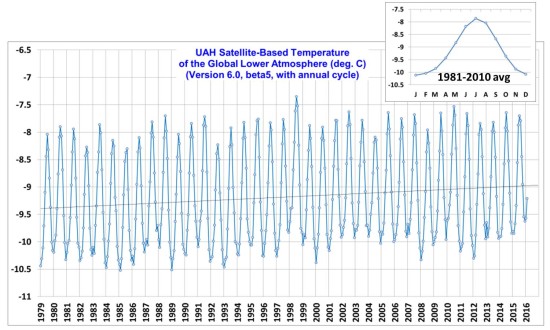I sometimes get asked, why don’t we post absolute temperatures, rather than anomalies from the seasonal cycle, for our satellite data?
The answer, of course, is that the seasonal cycle is so large that it obscures the departures from normal. So, we (and other climate researchers) do departures from the seasonal norms. (If someone in Minneapolis exclaims, “Can you believe that 50 deg. temperature we had?”, it makes a big difference whether it occurred in January or July).
Since we were asked (once again) for the averages, and had to compute them from the gridpoint annual cycles we post here, I thought I’d list them:
UAH LT global average annual cycle
Mon. Kelvin
JAN 263.037
FEB 263.108
MAR 263.299
APR 263.721
MAY 264.324
JUN 264.966
JUL 265.288
AUG 265.108
SEP 264.471
OCT 263.786
NOV 263.273
DEC 263.072
And here is what the time series of monthly global LT temperatures look like with the annual cycle added in:
The annual cycle is shown in the inset, with peak temperatures in July, due to the Northern Hemisphere land mass responding so strongly to summer sunlight. The linear trend is +0.11 C/decade (it’s +0.12 C/decade with the annual cycle removed, which is how it should be done otherwise the annual cycle can be aliased into the trend calculation).

 Home/Blog
Home/Blog




